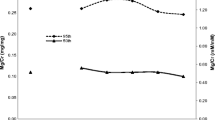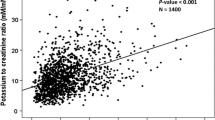Abstract
Prompted by a large population of children with renal stones seen in 20 of our country's teaching hospitals over the past 10 years, this study of urinary mineral excretion in normal children was performed. Fasting urine from 1,072 normal Taiwanese school children and 24-h urine collections from 125 children separated into three age groups were analysed for calcium (Ca), phosphate, magnesium (Mg), uric acid, sodium (Na) and creatinine (Cr). Fasting Ca/Cr ratios were not different between the sexes. Ca/Cr ratios were higher in the 17- to 18-year age group as were 24-h urinary Ca excretions. Urinary Mg/Cr ratios were higher in girls than boys and 24-h urinary Mg excretion was highest in the younger age groups. Urinary Mg excretion in Taiwanese children is 54%–86% lower than previously reported in Caucasian children. Both uric acid/Cr ratios and 24-h urinary uric acid excretion were highest in the youngest children. Urinary Na/Cr ratios and 24-h urinary Na excretion were higher in the two younger age groups. There was no correlation between 24-h urinary Ca and Na excretion.
Similar content being viewed by others
References
Lama G, Carbone MG, Marrone N, Russo P, Spagnuolo G (1990) Promoters and inhibitors of calcium urolithiasis in children. Child Nephrol Urol 10: 81–84
Fleisch H (1978) Inhibitors and promoters of stone formation. Kidney Int 13: 361–371
Pak CYC (1986) Pathogenesis of hypercalciuria. In: Peck WA (ed) Bone and mineral disease. Elsevier, New York, pp 303–333
Goldwasser B, Weinerth JL, Carson CC III (1986) Calcium stone disease: an overview. J Urol 135: 1–9
Lorentz K (1982) Improved determination of serum calcium with 2-cresolphthalein complexone. Clin Chim Acta 126: 327–334
Garber CC, Miller RC (1983) Revisions of the 1963 semidine HCl standard method for inorganic phosphorus. Clin Chem 29: 184–188
Hansen JL, Frier EF (1967) The measurement of serum magnesium by atomic absorption spectrophotometry. Am J Med Technol 33: 158–166
Bowers LD, Wong ET (1980) Kinetic serum creatinine assays. II. A critical evaluation and review. Clin Chem 26: 555–561
Gochman N, Schmitz JM (1971) Automated determination of uric acid, with use of a uricase-peroxidase system. Clin Chem 17: 1154–1159
Watts RWE (1989) Factors governing urinary tract stone disease. Pediatr Nephrol 3: 332–340
Tsai YC, Chen HH, Wu JY, Hsu CP, Hwang CJ, Yang TH (1980) A dietary survery on the juvenile group of Tapei City area. J Chin Nutr Soc 5: 7–17
Lee NY, Chu YC, Chang CP, Shieh MJ, Kao MD (1991) Dietary survery in Taiwan area. J Chin Nutr Soc 16: 39–60
Desanto NG, Iorio BD, Capasso G, Paduano C, Stamler R, Langman CB, Stamler J (1992) Population based data on urinary excretion of calcium magnesium, oxalate, phosphate and uric acid in children from Cimitle (Southern Italy). Pediatr Nephrol 6: 149–157
Moore ES, Coe FL, McMann BJ, Favus MJ (1978) Idiopathic hypercalciuria in children: prevalence and metabolic characteristics. J Pediatr 92: 906–910
Stapleton FB, Noe HN, Jerkins G, Roy S III (1982) Urinary excretion of calcium following an oral calcium loading test in healthy children. Pediatrics 69: 594–597
Ghazali S, Barratt TM (1974) Urinary excretion of calcium and magnesium in children. Arch Dis Child 49: 97–101
Rodriguez-Soriano J, Vallo A, Garcia-Fuentes M (1987) Hypomagnesemia of hereditary renal origin. Pediatr Nephrol I: 465–472
Sa G, Proenca H, Rosa FC (1992) Normal ranges for urinary excretion of calcium and magnesium in Portuguese children. Pediatr Nephrol 6: 313
Hodgkinson A (1974) Relations between oxalic acid, calcium, magnesium and creatinine excretion in normal men and male patients with calcium oxalate kidney stones. Clin Sci Mol Med 46: 357–367
Ljunghall S, Waerr AU (1977) Urinary electrolytes in renal stone formers and healthy subjects. Scan J Urol Nephrol [Suppl] 41: 55–75
Churchill DN, Black DP, Maloney CM, Gault MH (1981) Urinary chemistry in renal stone formers in an area with soft drinking water. In: Smith LH, Robertson WG, Finlayson B (eds) Urolithiasis, clinical and basic research. Plenum, New York, pp 349–352
Stapleton FB, Linshaw MA, Hassanein K (1978) Uric acid excretion in normal children. J Pediatr 92: 911–914
Author information
Authors and Affiliations
Rights and permissions
About this article
Cite this article
Chen, YH., Lee, AJ., Chen, CH. et al. Urinary mineral excretion among normal Taiwanese children. Pediatr Nephrol 8, 36–39 (1994). https://doi.org/10.1007/BF00868256
Received:
Revised:
Accepted:
Issue Date:
DOI: https://doi.org/10.1007/BF00868256




